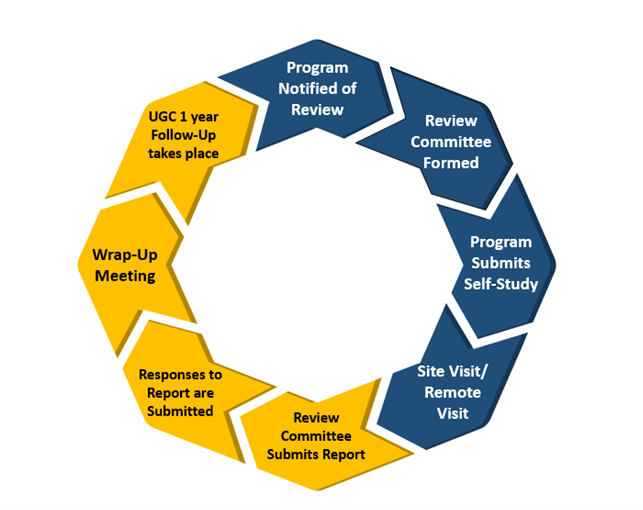Program Reviews
Program reviews are a requirement for all colleges, departments, and programs at UC San Diego. Reviews may be undergraduate, graduate, or combined. Combined reviews involve a simultaneous review of both the undergraduate and graduate programs within a department.
What is a program review?
Program review is a structured process for examining both the strengths of a unit and areas for growth. Reviews focus on evidence of improvement, responsiveness to data, attention to equity gaps, and planning for the future. Because reviews occur only once every 7–8 years, they provide a valuable opportunity to step back, take stock, and reflect honestly on where the program has been and where it is heading. Transparency is essential—highlighting both achievements and challenges demonstrates meaningful self-reflection and helps set priorities for the future.
Each review includes three key elements:
- A reflective self-study
- A review committee virtual visit and written report
- Responses to the report from the program, school, and Senate
Why are program reviews a requirement?
Periodic program reviews:- Support UC San Diego’s mission to be a student-centered university that advances equity in education
- Align with standards set by our accrediting agency
- Provide a structured opportunity for reflection, planning, and improvement
How should units prepare?
Units are expected to approach program review with a commitment to improvement, using data and evidence to guide reflection and planning. Reviews should highlight ongoing assessment work, attention to equity gaps, and the ways programs adapt to a changing environment. See preparing for program review for more details.

When are reviews scheduled?
Program reviews take place about every 7–9 years for each college, department, and program. The Division of Undergraduate Education (DUE) and the Division of Graduate Education and Postdoctoral Affairs (GEPA) coordinate with the Academic Senate to notify units in advance and outline the timeline.
Units are typically notified in winter quarter of the year prior to their actual review. The self-study is due the following winter, giving units most of the year to prepare, gather data, and draft their report. Reviews span an academic year and include opportunities for input from faculty, staff, advisors, teaching assistants, and students across the unit.
Then what:
The process does not end with the site visit. The goal is ongoing reflection and improvement. Here's a breakdown of what happens after the review:- The review committee submits its report.
- The academic unit, School dean, and other leadership review and respond.
- The Undergraduate Council — and, for graduate or combined reviews, the Graduate Council — consider the report and responses, and issue recommendations.
- DUE (for undergraduate reviews) or DUE and GEPA together (for combined reviews) schedule a wrap-up meeting with the unit, the school dean, the EVC, and others to discuss findings and next steps.
- About a year later, the unit conducts follow-up activities and submits a follow-up response.
- UGC (and GC, if applicable) review the follow-up and may issue additional recommendations.
- The unit begins preparing for its next review—using lessons learned to continue improving over the next several years.